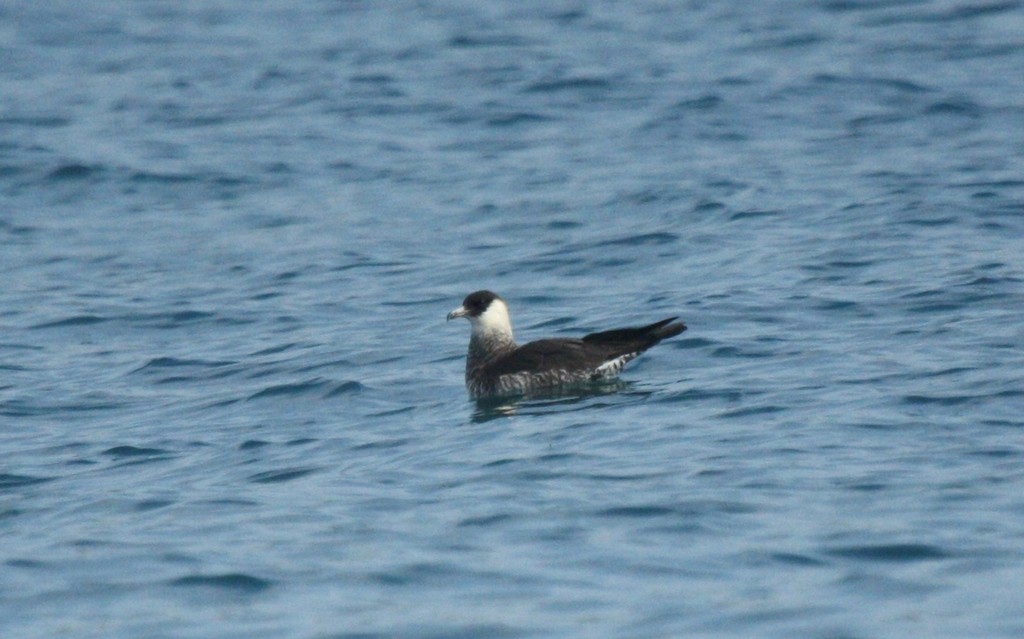Pomarine Jaeger
A species of Jaegers, Also known as Pomatorhine Skua, Gull-hunter Scientific name : Stercorarius pomarinus Genus : Jaegers
Pomarine Jaeger, A species of Jaegers
Also known as:
Pomatorhine Skua, Gull-hunter
Botanical name: Stercorarius pomarinus
Genus: Jaegers
Content
Description General Info
 Photo By silversea_starsong , used under CC-BY-NC-4.0 /Cropped and compressed from original
Photo By silversea_starsong , used under CC-BY-NC-4.0 /Cropped and compressed from original Description
This species ranges from 46 to 67 cm (18 to 26 in) in length, 110 to 138 cm (43 to 54 in) in wingspan and 540–920 g (1.19–2.03 lb) in weight. The upper limit of the length includes the elongated tail streamer of breeding adults, which is about 10 cm (3.9 in) in length. Identification of this jaeger is complicated by its similarities to parasitic jaeger and the existence of three morphs. Pomarine jaegers are larger than common gulls. They are much bulkier, broader-winged and less falcon-like than the parasitic jaeger, but show the same wide range of plumage variation. The flight is more measured than that of the smaller species. It has many harsh chattering calls and others which sounds like which-yew. Light-morph adult pomarine jaegers have a brown back, mainly white underparts and dark primary wing feathers with a white "flash". The head and neck are yellowish-white with a black cap. Dark morph adults are dark brown, and intermediate morph birds are dark with somewhat paler underparts, head and neck. All morphs have the white wing flash, which appears as a diagnostic double flash on the underwing. In breeding adults of all morphs, the two central tail feathers are much longer than the others, spoon-shaped, and twisted from the horizontal. Juveniles are even more problematic to identify, and are difficult to separate from parasitic jaegers at a distance on plumage alone. 
Size
51-58 cm (20-23 in)
Life Expectancy
15 years
Nest Placement
Ground
Clutch Size
1 - 2 eggs
Incubation Period
1 brood
Number of Broods
25 - 27 days
Nestling Period
2 - 4 days
Feeding Habits
Pomarine Jaeger primarily feeds on brown lemmings during breeding, impacting its breeding success based on lemming population cycles. It hunts by scanning from elevated tundra positions post-snowmelt, sometimes catching shorebirds, ducks, and ptarmigan. Nonbreeding season diet includes lemmings, various birds, eggs, carrion, insects, fish, squid, and crabs. Pomarine Jaeger is known for kleptoparasitism, chasing other seabirds to steal prey, displaying remarkable agility in aerial pursuits. It is only occasionally predated by certain large bird species.
Habitat
Pomarine Jaeger commonly inhabit open sea and coastal offshore areas. They thrive in arctic tundra during the breeding season, where their breeding reliance on lemming populations can influence their migratory patterns. Pomarine Jaeger require expansive tundra landscapes rich in their rodent prey. In non-breeding seasons, these birds are pelagic, frequenting marine environments far from land, with notable congregations in the Caribbean Sea.
Nest Behavior
Both sexes collaborate to trample and line the nest. Pomarine Jaeger displays specific patterns in nest-building, egg-laying, and engages in shared parental responsibilities.
Nest Characteristics
Pomarine Jaeger nests are found on tundras, placed on slight elevations or hummocks. They consist of trampled depressions lined with local vegetation.
Dite type
Omnivorous
General Info
Feeding Habits
Bird food type
Behavior
Pomarine Jaeger exhibit a robust and somewhat aggressive demeanor, especially when procuring food. Unlike their more nimble jaeger counterparts, they favor a straightforward, forceful approach in kleptoparasitic engagements, commandeering meals from other seabirds. Commonly found in oceanic gatherings, they do not shy away from social interaction and may even rest on water alongside different avian species. On their breeding grounds, pomarine Jaeger demonstrate territorial behavior through vocal warnings and deliberate aerial or grounded wing displays, showcasing distinctive white markings to deter interlopers. These displays double as courtship rituals during mating season. Pair bonding is a notable aspect of their reproductive strategy, with both partners actively contributing to the upbringing of their offspring.
Species Status
Not globally threatened.
Scientific Classification
Phylum
Chordates Class
Birds Order
Shorebirds Family
Skuas and jaegers Genus
Jaegers Species
Pomarine Jaeger